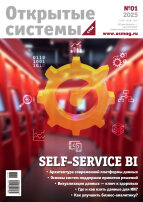.jpg) COVER FEATURES
COVER FEATURES
HIGH PERFORMANCE COMPUTER ARCHITECTURE
The Law is dead... Long Live the Law!
Those who believe in the inevitable demise of Moore's law are right, as are those who are convinced of its immortality: this is really a question of the law's interpretation.
Leonid Chernyak (osmag@osp.ru), freelance writer
Power Family Has a New Member
A new CPU always makes a splash, especially against the backdrop of a single-vendor stronghold and in the light of huge costs associated with the development of new microprocessing architectures. A new member of Power RISC CPU marks a next step towards adapting hardware architectures for new era applications.
Mikhail B. Kuzminsky (kus@free.net), Senior Research Fellow, Institute of Organic Chemistry
Back to Efficiency
The development path of computing architectures largely depends today on lowering the cost per unit of performance, for instance through cutting energy expenses. Liquid cooled HP Apollo systems represent a step in this direction.
Valeriy Korzhov (osmag@osp.ru), freelance writer
Big Data and HPC
Big Data Analytics requires using high-performance computing systems, but there are many obstacles hindering the convergence of the two worlds. What is needed to be done to address the task of big data processing on supercomputers?
Dmitry V. Volkov (vlk@keldysh.ru), Senior Research Fellow, Keldysh Institute of Applied Mathematics; Lev Levin (osmag@osp.ru), freelance writer
PLATFORMS
Key Data Storage System Architectures
In 2013, storage systems market grew over $22 billion. It has no clear leaders now while the users have difficulties tracking new trends or understanding evaluation criteria of emerging solutions. Yet, knowing the architectures and technologies along with their development directions helps to choose right storage solutions for one's particular needs.
Andrey Subbotin (Andrey.Subbotin@R-Style.com), lead consultant, appliances department, R-Style
CLOUD COMPUTING
Cloud Illusions
Despite the growing popularity of cloud computing, there are still several myths that hinder migrating into the cloud or create false expectations.
Mark Rivkin (mark.rivkin@oracle.com), technical consulting senior manager, Oracle CIS
Analysis of Web-Scale Cloud Services
Cloud services have unique characteristics, including dynamic and diverse service offerings at different levels, few standardized description languages, and varied deployment platforms. Searching such services is thus challenging. The authors’ cloud service crawler engine collects metadata about 5,883 cloud services over the Web after parsing more than half a million possible links. An extensive statistical analysis on this data gives an overall view of cloud service provisioning’s current status.
Talal H. Noor (tnoor@taibahu.edu.sa), assistant professor, Department of Computer Science, Taibah University; Quan Z. Sheng (qsheng@cs.adelaide.edu.au), associate professor, School of Computer Science, University of Adelaide; Anne H.H. Ngu (angu@txstate.edu), full professor, Department of Computer Science, Texas State University; Schahram Dustdar (dustdar@dsg.tuwien.ac.at), full professor of computer science, Vienna University of Technology
INTEGRATION
Modern Expert Networks
Global expert services crowdsourcing market is being reborn now after a confidence crisis. In Russia, expert network are yet to gain the necessary momentum.
Boris Slavin (bbslavin@gmail.com), research head, applied math and IT department, Financial University under the Government of the Russian Federation
SECURITY
Attacks on GPS Time Reliability
Many systems depend on synchronized precise time, such as systems for financial transactions, telecommunications, and industrial control. Some of these systems might be geographically dispersed and have coordination and control schemes that require interoperability with other systems. Of the available time sources, GPS has shown that it can cost-effectively provide microsecond precision over a dispersed area. But malicious events can cause GPS signals to be lost altogether or deliberately incorrect.
Chris Bonebrake (bonebrake@pnnl.gov), scientist, Pacific Northwest National Laboratory; Lori Ross O’Neil (lro@pnnl.gov), senior research scientist, Pacific Northwest National Laboratory
SOFTWARE ENGINEERING
The DevOps Culture
Most often, DevOps is referred to as a software development and operation methodology based on communication and collaboration between the respective teams. First and foremost, however, DevOps is a culture, and only then, it is a practice.
Svyatoslav Vereshchak (sve@express42.com), consultant, Express 42
DBMS
Environment for Logical Data Warehouse Deployment
A year after introducing its logical warehouse solution, Unified Data Architecture, Teradata is now offering QueryGrid environment that federates various platforms into a single resource pool for storing and processing multiple data types.
Mikhail Ganyushkin (Mikhail.Ganyushkin@Teradata.com), solutions architect, Teradata Russia
OS MUSEUM
The Dawn of the Digital Era
1960s were landmark years for Russia standing on the verge of the Digital Era: new computers are put to use, first algorithmic languages are created requiring the development of translators and application software, to say nothing of the operating systems for the new machines. Scientists in USSR computing centres and universities, including in Keldysh Institute of Applied Mathematics of the Soviet Academy of Sciences, have taken on those tasks.
Galina Yezerova (keldysh111@gmail.com), scientist; Engelina Lukhovitskaya (luhov@list.ru), scientist, Keldysh Institute of Applied Mathematics
OS ACADEMY. Library
Mobile Platforms Security
The June issue of Computer Magazine (IEEE Computer Society, Vol. 47, No. 6, 2014) covers the topic of mobile applications security.
Sergey D. Kuznetsov (kuzloc@ispras.ru), Professor, Moscow State University
